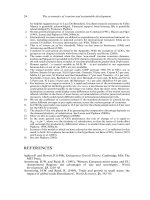THE ECONOMICS OF MONEY,BANKING, AND FINANCIAL MARKETS 394
Bạn đang xem bản rút gọn của tài liệu. Xem và tải ngay bản đầy đủ của tài liệu tại đây (42.29 KB, 1 trang )
362
PA R T I V
The Management of Financial Institutions
chooses. The seller of an option, by contrast, has no choice in the matter; he or she
must buy or sell the asset if the owner exercises the option.
Because the right to buy or sell an asset at a specified price has value, the
owner of an option is willing to pay an amount for it called a premium. There
are two types of option contracts: American options can be exercised at any
time up to the expiration date of the contract, and European options can be exercised only on the expiration date.
Option contracts written on individual stocks are called stock options, and
such options have existed for a long time. However, option contracts can also be
written on assets. Options on financial futures called financial futures options
or, more commonly, futures options, were developed in 1982 and have become
the most widely traded option contracts.
You might wonder why option contracts are more likely to be written on financial futures than on underlying financial instruments such as bonds. As you saw
earlier in the chapter, at the expiration date, the price of the futures contract and
of the deliverable debt instrument will be the same because of arbitrage. So it
would seem that investors should be indifferent about having the option written
on the asset or on the futures contract. However, financial futures contracts have
been so well designed that their markets are often more liquid than the markets
in the underlying assets. Investors would rather have the option contract written
on the more liquid instrument, in this case the futures contract. That explains why
the most popular futures options are written on many of the same futures contracts
listed in Table 14-1.
In Canada, the regulation of option markets is the responsibility of the
Canadian Derivatives Clearing Corporation (CDCC), a firm that is jointly owned by
Canada s stock exchanges: the Toronto Stock Exchange, the TSX Venture
Exchange, and the Montreal Exchange. The regulation of U.S. option markets is
split between the Securities and Exchange Commission (SEC), which regulates
stock options, and the Commodity Futures Trading Commission (CFTC), which
regulates futures options. Regulation focuses on ensuring that writers of options
have enough capital to make good on their contractual obligations and on overseeing traders and exchanges to prevent fraud and ensure that the market is not
being manipulated.
Stock Options
To understand option contracts more fully, let s first discuss stock options (options
on individual stocks) before we turn to the more complicated futures options (that
is, options on financial futures).
A call option is a contract that gives the owner
the right (but not the obligation) to buy a stock (from the option writer) at the
exercise price within a specific period of time. Since a call represents an option
to buy, the purchase of a call is undertaken if the price of the underlying stock is
expected to go up. The buyer of a call is said to be long in a call and the writer
of a call is said to be short in a call. The buyer of a call option will have to pay
a premium, called a call premium, in order to get the writer to sign the contract
and assume the risk.
To illustrate the profitability of a call option, suppose you hold a European call
option on an equity security with an exercise price of X (say $100) and a call premium of * (say $5), as shown in Figure 14-1. If at the expiration date, the price of
the underlying asset, S, is less than X, the call will not be exercised, resulting in a
loss of the premium. At a price above X, the call will be exercised. In particular,
PROFITS AND LOSSES ON CALLS









